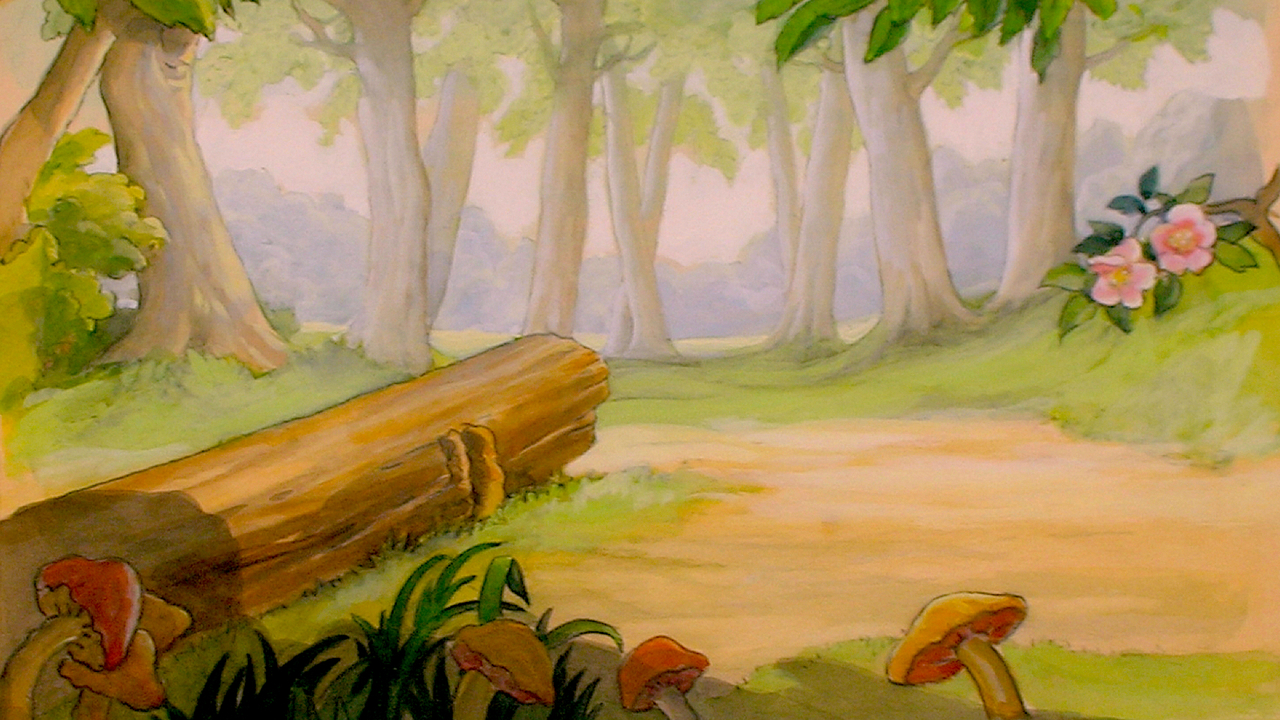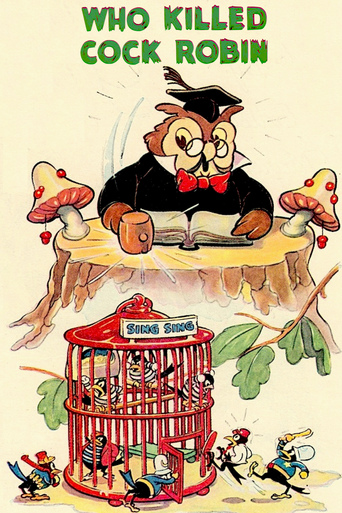

"Silly Symphony". I groaned whenever the cardboard popped up instead of the face of Donald, Goofy or Pluto. As an adult, I can see how the series -starting with the unbearably mawkish "Flowers and Trees" but culminating with the heart-pounding masterpiece "The Old Mill"- allowed Walt Disney to sweep many Oscars and make his bones before the groundbreaking "Snow White and the Seven Dwarfs". Still, even as a child, I was never drawn into the whole lyrical imagery driven by cutesy songs I didn't even understand, so I used to tape over these darn cartoons whenever they were caught on my VHS. Two exceptions though: "The Pied Piper of Hamelin" and its catchy 'Rats, Rats, Rats' and the classic of all the classics, the gripping and captivating "Who Killed Cock Robin?", and while I'm writing these lines, I have the ominous melody playing in my head and that simple but riveting interrogation mark on screen. I was eight when I first saw it, and after "Hello" and "Goodbye", one of the first sentences I learned in English was "Who killed... ?" closely followed by "I don't know".This is a case of love at first sight that the passing of years never soiled, I loved it as a kid, I love it even more as an adult. It's a combination of factors... but first, there's the story, built up like a real mystery thriller. Whistling a sweet and hypnotic melody, Robin calls his beloved Jenny Wren out of her balcony, she makes her entrance with these words "Oh Robin, you're fascinating me!" and says it like she means it. Verbal lyrics might have overplayed the sentimentality, but Robin's repetitions of "Ba-ba-boo" and "Ba-ba-bee" indicates the smart angle taken by the animators, it's a romance sure, but smartly coated with dark comedy.Speaking of the dark, the mysterious shadow of an bow-wielding bird is slowly approaching until the serenade is literally cut short by the arrow, hitting him right in the heart. Robin looks overwhelmed with love before a long fall. As he hits the ground, three agonizing "Ba-boo" come off his beak then three faces come out the saloon, if you pay attention, they'll be the three suspects. What we've got after is your archetypal crime's aftermath except that it's set is an anthropomorphic universe occupied by birds, so the Police are coming, followed by an ambulance. Robin is nonchalantly put on a stretcher (you can't tell from the carriers' expression how routinely it is) and cops move away the bystanders but take the three suspects out of the bar. "I done nothing" repeats one of them, then the Cop, with an unmistakable Irish accent tells him to keep that for the judge, he hits him several times in the head and a remarkable ellipse cuts from the stick to a courtroom gravel hammer. Naturally, the Judge is an owl he sounds like James Earl Jones. "Who killed Cock Robin?" he gravely asks. The Jury plays like a Greek chorus and repeats all the lyrics with the smoothness of a Barbershop quartet. In two minutes, the tone is set, it's dark, subversive and yet funny. The film was made in 1935, where I believe three of the finest Disney cartoons were made: "The Band Concert", "Pluto's Judgment Day" and this one. Interestingly, the one with "Pluto" also featured an unfair atmospheric trial. Was it the context of the Stalin purges or a pure coincidence? What I know is that it's a unique case of Disney showing a form of justice as zealous as incompetent, when a poor black bird is getting hit because "I don't know" and "I saw nothing" are no acceptable answers and where a big shot is only sitting on the accused' nest because he "looks guilty", according to the parrot-prosecutor. The portrayal of the Black bird can be deemed as politically incorrect but is he not a victim after all and aren't the representatives of the legal system getting a worse deal? Think of the scene where Jenny Wren comes in and after a melodious and suave call for justice, the Judge who's not the least insensitive to her charm, decides to hang them all, and as the jury jollily chants in my favorite moment, "we don't know who's guilty so we're gonna hang them all". If it wasn't so hilarious, it would be tragic, no wonder, an arrow hits the judge's hat while he's dancing and someone says "stop!". It was time to stop!And then comes the last outrage, the killer was Cupid, and Robin wasn't dead, he just fell in love and Cupid seems to be pretty gay about the whole thing (pun intended). It takes one "Kiss me, tall, dark and handsome" so Robin can slowly resurrect, the umbrella covers his face and Jenny raises her head with the kind of moan that makes you wonder where Robin's beak is, and the jury can only duplicate the sound while waving their hats to make some air, the heat is just too much. "Who Killed Cock Robin" has a set-up, an investigation, a twist and a resolution with quite daring sexual innuendo. That's why as an adult, I naturally learned to appreciate even more.And it wasn't until I became a movie buff, that I realized Cock Robin was Bing Crosby, Jenny Wren was Mae West, the cuckoo a mix of Harpo and Groucho Marx and the whole cartoon a powerful reflection of its time the film, depicting a world of crime with drinking, smoking, killing, brutal arrests, arbitrary justice and sex. To those who believe that Walt Disney is just about political correctness, they should watch this film and reevaluate their preconceived opinions. And ever since I was eight, this has been a favorite of mine, a treasure I'll always cherish, I'm almost three decades older and I still tell my Dad if he remembers "Whooooo killed Cock Robin?". You bet he does!
... View MoreAlmost every cartoon short Disney released in 1935 are bonafide classics. Nominated for an Academy Award, Who Killed Cock Robin is one of the edgiest of the Silly Symphonies. By the mid-30's, most Silly Symphonies used fables and nursery rhymes as source material, gearing up for the feature films that would follow. It is especially interesting to see, that Disney dabbled into satire early on. Some of the characters in the film are caricatures of well known entertainers of the 30's. Cock Robin sings like Bing Crosby, Jenny Wren resembles and sounds like Mae West. Yet not all the birds are caricatures, when they easily could have been. Some of the artists expressed regret in later years that they didn't go that direction in full. Disney would accomplish this a few years later with "Mother Goose Goes Hollywood" (1938).Not only are celebrities satirized, but there is also a subtle jab at the justice system (a theme also explored in Pluto's Judgement Day, released the same year). This is summed up by a line that comes from the jury chorus "We don't know who is guilty so we're going to hang them all". The suspects were arrested at random with no evidence tying them to killing Cock Robin.Considering how rival cartoon studios were attempting to emulate Disney at this time, I've always wondered if the crime setting and bird characters influenced the WB cartoon "I'm A Big Shot Now" (1936); Chiefly the character Legs Sparrow.While this short was a popular Disney short, it hasn't been shown very much in recent decades. This is due to ethnic stereotypes (the "black bird" is a caricature of Stepin Fetchit) and police brutality. But it is still regarded as one of the best Disney cartoons by historians. These themes make it a Disney cartoon with strong adult appeal.
... View MoreThis notable entry in Walt Disney's famous Silly Symphony series is perhaps best remembered for its parodies of current movie stars, including Bing Crosby, Harpo Marx, and -- most spectacularly -- Mae West, but seen today the film is even more striking for its subversive treatment of the legal system. The sassy attitude on display here smacks more of the Fleischer Studio or the wise-guy aggressiveness of Warner Brothers' Termite Terrace boys than what we usually get from Uncle Walt. This cartoon also appears to have just barely slipped past the newly strict Hays Office censors with its naughty insinuations (via Jenny Wren, the Mae West stand-in) and blatant "pansy" references.For the first few moments after the opening credits the tone is typical of a Silly Symphony: Cock Robin croons a love song to his girlfriend, as we take in the rich palette of Disney's Technicolor flowers and trees. Abruptly, Cock Robin is bumped off, plummeting to the ground before the Old Crow Bar in what looks like the seedy part of the woods, and suddenly we're in a different universe. As the morgue orderlies carry Cock Robin away, one of them casually tosses his hat onto the arrow protruding from his chest. A nice dark touch, that.Then the cops show up and roust three suspects out of the bar, and here's where things get really disturbing. All three suspects are dragged away and clubbed, but a black bird who talks like Stepin Fetchit and wears a white jacket is singled out for special brutality. Despite his protests that he "didn't do nuthin', don't know nuthin', and didn't see nuthin'" the black bird is clobbered repeatedly. The segue from the sequence before the trial to the trial itself is an amazingly bold cross-fade, timed to the rhythm of a cop clubbing this guy's head as it blends with the pounding of the judge's gavel. Eisenstein couldn't have done it better! And when the black bird repeats his denials, the jury mocks his cries with a minstrel show parody. It's only funny in the most grim sense of the word.Am I being excessively P.C. in examining a Disney cartoon in this fashion? I don't think so, nor am I calling the filmmakers racist. The animators who made this cartoon seem to be taking a very bleak view of the justice system and playing their own cynicism for laughs, the way the Marx Brothers took on politics in Duck Soup. But I do wonder how the cartoon went over in cinemas in African American neighborhoods. Did black audiences laugh ruefully? Or watch in stony silence?Beyond that, what's interesting to me about Who Killed Cock Robin? is the fact that, with the exception of Jenny Wren, the Hollywood caricatures really aren't central to the success of the whole. The Judge (an owl) and the D.A. (a parrot) are more impressive characters in terms of design than any of the others, and the jury acting as Greek Chorus is a great idea -- even if Gilbert & Sullivan thought of it first. Still, it's Jenny Wren we remember from this film, and this is where the animators and the uncredited performer who provided her voice really outdid themselves: this is a superb parody of Mae West that beautifully captures her look, her sound, her moves, and her style, especially in her courtroom musical number.All in all this is a remarkable cartoon, and one that the Disney Organization would never have made after the mid-1930s. Once the war came, and forever after, Uncle Walt never sanctioned anything that could be deemed critical of the American Way of Life.
... View MoreIn this Silly Symphony cartoon, Cock Robin is shot with an arrow while trying to woo Miss Jenny Wren (wonderfully animated as a Mae West parody). A trial featuring a wide variety of well drawn bird characters follows. The cuckoo bird, drawn to look like Harpo Marx, is especially enjoyable. This is a great short, but it seems to sprint through the story. Other Silly Symphonies, like The Wise Little Hen, take their time with things. This one seems very hurried. Still, that shouldn't take away from enjoying the wonderful animation.
... View More